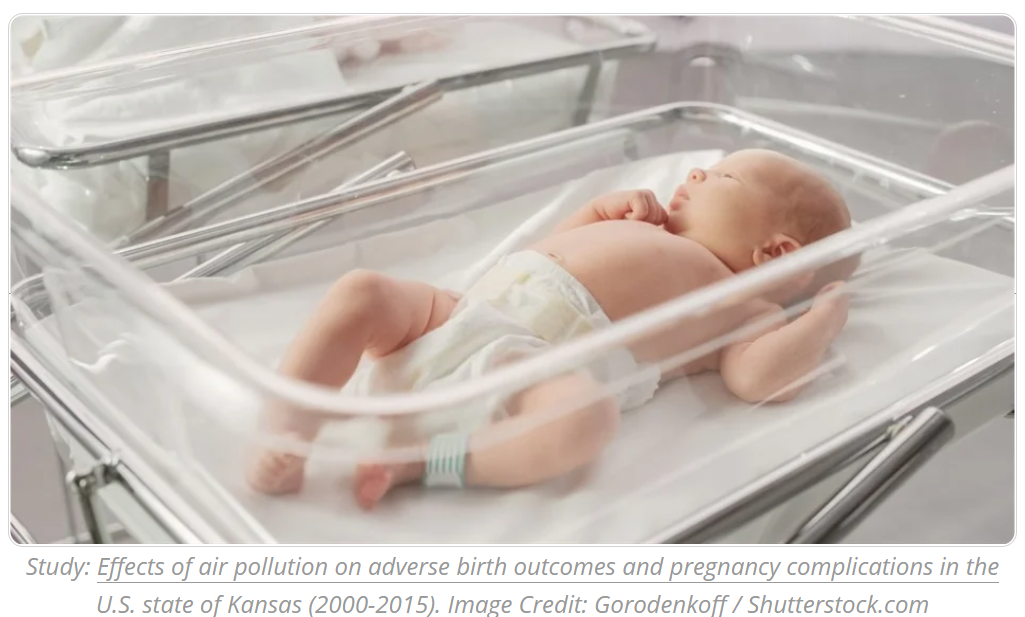A recent study published in the journal Scientific Reports emphasizes the importance of reducing exposure to air pollutants during pregnancy to prevent adverse outcomes like preterm birth and lower birth weight.

Background
The two major causes of mortality and morbidity in neonates are low birth weight and preterm birth, which can also lead to increased illness during adulthood. Some of the complications associated with preterm birth include impacts on the respiratory, central nervous, and digestive systems. The prevalence of low birth weight and preterm birth at 10.09% and 8.24%, respectively, necessitates additional epidemiological studies to elucidate their risk factors.
Gestational hypertension (GH) and gestational diabetes mellitus (GDM) are common maternal complications during pregnancy and can increase the risk of preterm birth and low birth weight. The burden of these conditions is growing globally and can lead to subsequent cardiometabolic and cardiovascular diseases.
Air pollution is considered a risk factor for low birth weight, preterm birth, GH, and GDM. However, the evidence on this association remains inconclusive and inconsistent, with conflicting findings.
About the study
Researchers analyzed the relationships between three air pollutants, including nitrogen dioxide (NO2), ozone (O3), and particulate matter of diameter below 2.5 μm (PM2.5), two pregnancy-related conditions of GH and GDM, as well as two birth-related outcomes of birth weight and preterm birth through a retrospective cohort study.
To investigate these correlations, secondary public health data from the Bureau of Epidemiology and Public Health Informatics in Kansas were used. Singleton pregnancies between 2000 and 2015 were included in the study, whereas any cases with missing or outlying data, as well as mothers who had hypertension or diabetes before pregnancy, were excluded.
Taken together, 590,574 and 449,871 pregnancies were included in GH and GDM modeling, respectively. The birth weight analysis had 554,787 births, whereas the preterm birth analysis involved 596,926 births.
For daily ambient air pollution data, spatiotemporal ensemble models were constructed with a spatial resolution of one km2. Exposure to pollutants was assessed separately during each trimester of pregnancy and throughout pregnancy. Single-pollutant and multi-pollutant models were used to determine the relationships between NO2, O3, and PM2.5 and the outcomes of interest.
Maternal characteristics such as race, ethnicity, education, age, birth parity, smoking status, and marital status were also analyzed. Socioeconomic status was estimated from greenspace in the zip code where the mother resided during the pregnancy and associated poverty data.
Study findings
Across 106 counties in Kansas, the prevalence of preterm birth was 7% and increased slightly throughout the study period. The average preterm birth weight was 2,499.5 g, whereas the average full-term birth weight was 3,410.9 g.
While NO2 and PM2.5 levels decreased over time, O3 levels increased. In a given exposure period, the correlations between the three air pollutants were moderate to low.
Higher exposure to O3 in terms of interquartile range (IQR) increased during the second or third trimester and throughout pregnancy was associated with an increased risk of preterm birth, with an odds ratio between 1.04 and 1.05. Similarly, babies born to mothers exposed to higher levels of O3 during the second and third trimesters were, on average, 9.86 g lighter at birth.
Mothers who were exposed to NO2 during the second trimester were more likely to have GDM, whereas those who were exposed to O3 in their first trimester were more likely to have GH.
The controlled models suggested that mothers living in areas with higher poverty levels experienced worse pregnancy complications and birth outcomes associated with their exposure to air pollution, thus indicating the protective effect of wealth. However, consistent results were not observed across all the pollutants and outcomes.
Conclusions
The study findings emphasize the role of higher O3 exposure in increasing the risk of lower birth weight, preterm birth, and GH. Similarly, NO2 exposure was associated with an increased risk of developing GDM.
These results are broadly similar to those from previous studies and meta-analyses worldwide. The observed effects of O3 exposure may be mediated through biological mechanisms such as systemic inflammation and oxidative stress.
Contrary to other studies and their expectations, no negative correlations were observed between pregnancy, maternal outcomes, and exposure to PM2.5. This could be because Kansas is a predominantly rural state with low overall levels of PM2.5.
The use of detailed high-resolution air pollution data was a major strength of the study, as was the use of birth records to remove potential recall bias. However, the authors were unable to include information on certain maternal-level risk factors such as illicit drug use, alcohol use, and previous preterm birth.
Since the data was based on live births, fetal death and pregnancy loss were not considered as possible outcomes associated with air pollution. Future research could address these gaps while exploring pollutant exposures at finer time scales to investigate this important health issue further.
Article Credit: news-medical